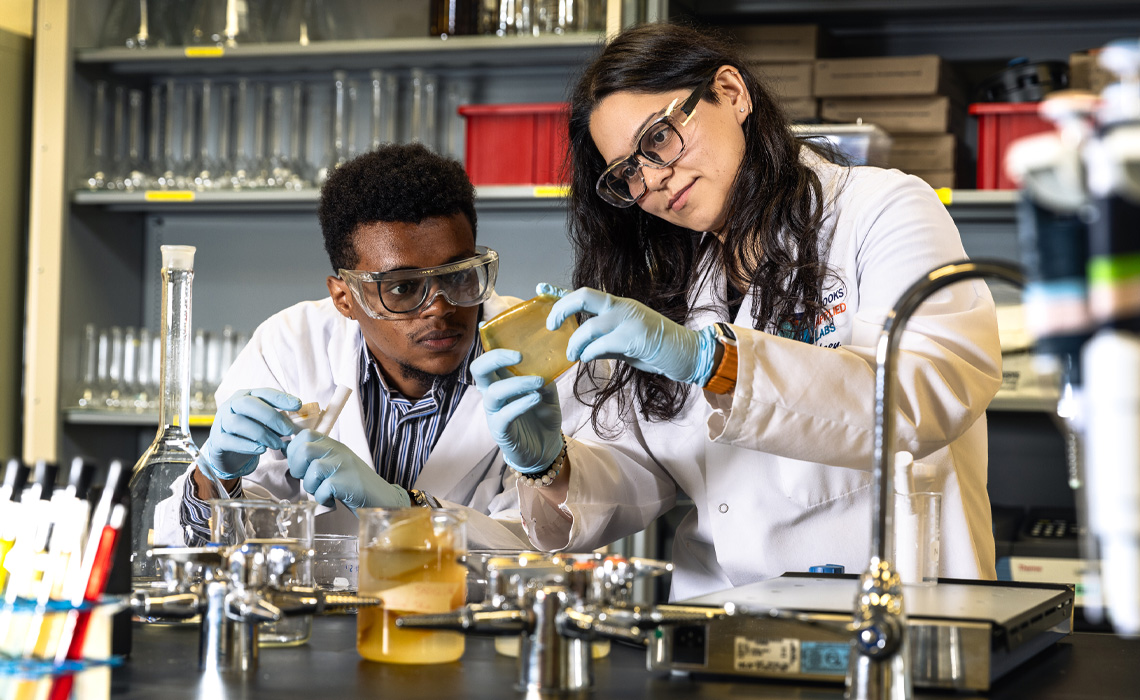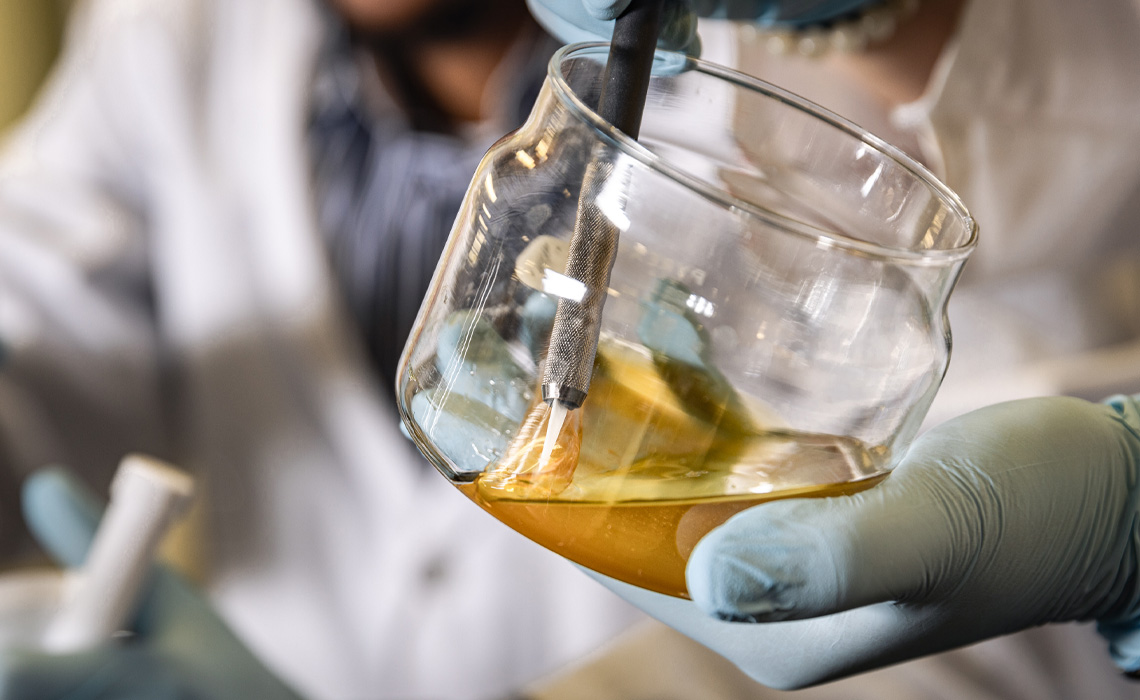What’s going into the body’s largest organ?

In 2023, Birhan Gezahegn was in his third year of his Bachelor of Science — Chemistry and eager to put his lab skills to use.
“Birhan came to me as one of my students in analytical chemistry and asked for a volunteer opportunity to do research with me. And I was more than happy. I love for my students to be really involved and engaged in the research they do,” says assistant professor of chemistry Nausheen Sadiq, PhD.
After some discussion, Gezahegn decided he would like to test skin products and cosmetics, which are a ubiquitous part of modern life. Consumers are constantly bombarded with the next great option to cover flaws, bring out features, moisturize dry skin, smooth out wrinkles and anything else that can be thought of. The assumption is that these products are safe and rigorously tested, however in Canada under the Food and Drugs Act producers are only required to provide a list of the product's ingredients and ensure they are being manufactured, prepared, preserved, packed and stored under sanitary conditions.
Sadiq, however, was concerned about the cost of such an inquiry. A common product for transdermal diffusion testing is called Strat-M, but it is expensive to buy and not representative of all ethnicities.
“It's a thin piece of white paper. It looks like a ghost and it's not skin-like at all,” Sadiq says. They needed to find a way to come up with a cost-effective alternative, both for the skin and the required apparatus.
The pair began looking into creating artificial skins that can mimic diversity. They discovered a product called chitosan, which is a sugar that comes from the outer skeleton of shellfish, including crab, lobster, and shrimp, and is normally used in the development of antimicrobial films for food packaging and for wound dressings due to its ability to form a gel. More recently, however, it has been used for tissue engineering.
“The more we looked around, we started finding solutions,” Gezahegn says. “We came to chitosan and we found that nobody has done elemental analysis on it as far as we are aware. It’s better in the way that you can mold it into whatever you want to achieve. The other ones are just given to you or sold to you as-is.”
Chitosan can be made to be inclusive of many skin types and ethnicities. “It’s something that's representative of everyone, or more than just one person, and really expands the project,” Sadiq says.
“What we're really excited about is these skins can mimic ages, they can mimic sex, they can mimic ethnicity, they can mimic so many different parts of your body and any kind of illness you might have,” Sadiq says. “We're actually considering, ‘What do people look like? What does the world around us look like and how safe are products for them?’ Some people are actually more at risk than others and we just haven't been talking about it.”
This kind of work often requires human or animal skin, Gezahegn says, “So there's the ethics of that. Also, dealing with human skin is very expensive because you have to store it in very specific conditions and you have to acquire a certain reagent, which is limited. If you want to do an examination of face skin, you can only acquire so much.
“But once you know about the thickness of face skin, you can design the chitosan to be the same. And molecular stability-wise, it's antibacterial, it's antifungal, so it can last a long time without being contaminated. It's very flexible, it's very cheap and it's very ethical.”
The diffusion cells needed for testing are also expensive to purchase. The solution came through MRU’s Library’s Maker and Media Commons 3D-printers, which the pair used to create their own cells. They then had their skin and their tools ready to go at a fraction of the cost.
Great-looking skin at what cost?
Gezahegn was particularly interested in testing a spectrum of skin products, specifically those that are touted as plant-based and vegan. This massive industry has been growing continuously as it appeals to those who want to make purchases that align with their consciences.
“People really want that cruelty-free touch to a lot of their products, which is fantastic. But it could come at a cost,” Sadiq says.
“When I say to you, ‘plant-based,’ we feel a certain level of safety, because it's natural. But now, with the increased agricultural use of fertilizers, pesticides and all the chemicals, does that translate into the products you use? That was my hypothesis going into it. So, last year we tested over 40 products and noted many baby products have been shown to be toxic to us. Products made in France end up having a lot of mercury in them. Those were new revelations to us,” Gezahegn says.
Another product that has been of interest to consumers lately is sunscreen. After years of being told sunscreen is an absolute must to apply when spending time outdoors, Gezahegn and Sadiq’s work has revealed that some ingredients may actually be harmful.
“We started looking at some baby sunscreens and some adult sunscreens as well. Things that you can find at your local drugstore. And some of the products that we were looking at, especially the baby products, had really high levels of cadmium and lead,” Sadiq says.

“Now, cadmium and lead are 100 per cent toxic to the human body. There's no good form of them. It's just all bad. And so if you're continuously applying it to your skin, especially babies, they're going to be extremely susceptible. What we're worried about is with that leaching and that permeation, that's something that's going to stay with them either in their body or in their skin.”
They also analyzed deodorants, face, lip and body products and insect repellents, and found that “aluminum-free" deodorants actually had high aluminum concentrations.
“While most of the other products are safe, they had higher zinc and aluminum levels and these elements aren't regulated like arsenic, lead or cadmium, for example,” Gezahegn says.
Gezahegn and Sadiq want consumers to be aware that the products they are purchasing may not be completely safe, for producers to be more transparent and for the government to hold them to account.
“Sometimes it can be difficult to look at a bunch of ingredients that you may not be able to read out loud. And so it's not always the best telling point of, ‘Is this safe or this is unsafe.’ But I think there's a lot to be said about knowing, demanding that your product should not contain things that can give you cancer, that can give you any kind of conditions or ailments. And so a lot of the hope for our work is that we can get that awareness out to not just the manufacturers and producers, but to government bodies in terms of regulations that may or may not currently exist. And then also bring it back to consumers and make them more aware and have them ask for this kind of testing. This kind of testing should be done on any and all products that we have access to here. And if they're currently not at the level that we think is enough. Something has to change,” Sadiq says.
Research gaining grip
Last summer Gezahegn obtained funding for his work through the Natural Sciences and Engineering Research Council of Canada (NSERC) Undergraduate Student Research Awards (USRA), which, “I would argue, as part of the Canadian government, is the highest honour that an undergraduate student can get,” Sadiq says.
Gezahegn then went on to win second place for his poster at the annual International Conference on Analytical Sciences and Spectroscopy (ICASS) in 2023.
This summer Gezahegn received the NSERC USRA grant again and took home the top prize at ICASS for a poster project authored with fellow student Lisa Tritz titled, “Wait! Is that human skin? Optimization of artificial skin to reflect age and ethnicity to determine elemental risk associated with cosmetics using ICP-MS.” Sadiq also received the travel award for the inaugural GLOW 2024 conference for women leaders and emerging researchers in materials science, allowing her to present the research in Singapore.
Gezahegn is working on a publication and is starting his master’s at the University of Alberta in material chemistry this fall. He’d like to work more with chitosan, which can also be dried to become a membrane. “If you find ways to dry it into small pieces, then I can make nano-particle structures. So whatever your need, this material will fit that,” such as perhaps trapping some drugs within and monitoring their controlled release.
Looking forward to a bright future in science, Gezahegn credits Sadiq with making his MRU experience a satisfying one.
“She took a chance with me. It became more of a symbiotic, constructive relationship. We faced problems, we talked about it, we found solutions. She's like a train. She breaks barriers. So if you are on that train, you are guaranteed to reach somewhere.”

